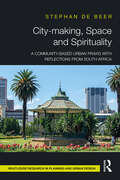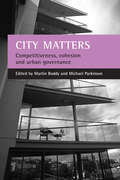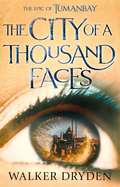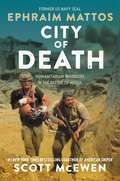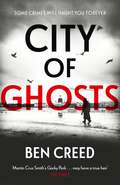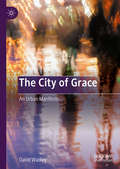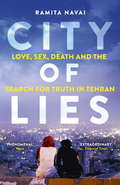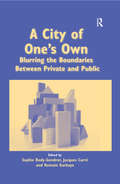- Table View
- List View
City Logistics 3: Towards Sustainable and Liveable Cities
by Eiichi Taniguchi Russell G. ThompsonThis volume of three books presents recent advances in modelling, planning and evaluating city logistics for sustainable and liveable cities based on the application of ICT (Information and Communication Technology) and ITS (Intelligent Transport Systems). It highlights modelling the behaviour of stakeholders who are involved in city logistics as well as planning and managing policy measures of city logistics including cooperative freight transport systems in public-private partnerships. Case studies of implementing and evaluating city logistics measures in terms of economic, social and environmental benefits from major cities around the world are also given.
City Logistics 3: Towards Sustainable and Liveable Cities
by Eiichi Taniguchi Russell G. ThompsonThis volume of three books presents recent advances in modelling, planning and evaluating city logistics for sustainable and liveable cities based on the application of ICT (Information and Communication Technology) and ITS (Intelligent Transport Systems). It highlights modelling the behaviour of stakeholders who are involved in city logistics as well as planning and managing policy measures of city logistics including cooperative freight transport systems in public-private partnerships. Case studies of implementing and evaluating city logistics measures in terms of economic, social and environmental benefits from major cities around the world are also given.
City Making: Building Communities without Building Walls (PDF)
by Gerald E. FrugAmerican metropolitan areas today are divided into neighborhoods of privilege and poverty, often along lines of ethnicity and race. City residents traveling through these neighborhoods move from feeling at home to feeling like tourists to feeling so out of place they fear for their security. As Gerald Frug shows, this divided and inhospitable urban landscape is not simply the result of individual choices about where to live or start a business. It is the product of government policies--and, in particular, the policies embedded in legal rules. A Harvard law professor and leading expert on urban affairs, Frug presents the first-ever analysis of how legal rules shape modern cities and outlines a set of alternatives to bring down the walls that now keep city dwellers apart. Frug begins by describing how American law treats cities as subdivisions of states and shows how this arrangement has encouraged the separation of metropolitan residents into different, sometimes hostile groups. He explains in clear, accessible language the divisive impact of rules about zoning, redevelopment, land use, and the organization of such city services as education and policing. He pays special attention to the underlying role of anxiety about strangers, the widespread desire for good schools, and the pervasive fear of crime. Ultimately, Frug calls for replacing the current legal definition of cities with an alternative based on what he calls "community building"--an alternative that gives cities within the same metropolitan region incentives to forge closer links with each other. An incisive study of the legal roots of today's urban problems, City Making is also an optimistic and compelling blueprint for enabling American cities once again to embrace their historic role of helping people reach an accommodation with those who live in the same geographic area, no matter how dissimilar they are.
City Making: Building Communities without Building Walls
by Gerald E. FrugAmerican metropolitan areas today are divided into neighborhoods of privilege and poverty, often along lines of ethnicity and race. City residents traveling through these neighborhoods move from feeling at home to feeling like tourists to feeling so out of place they fear for their security. As Gerald Frug shows, this divided and inhospitable urban landscape is not simply the result of individual choices about where to live or start a business. It is the product of government policies--and, in particular, the policies embedded in legal rules. A Harvard law professor and leading expert on urban affairs, Frug presents the first-ever analysis of how legal rules shape modern cities and outlines a set of alternatives to bring down the walls that now keep city dwellers apart. Frug begins by describing how American law treats cities as subdivisions of states and shows how this arrangement has encouraged the separation of metropolitan residents into different, sometimes hostile groups. He explains in clear, accessible language the divisive impact of rules about zoning, redevelopment, land use, and the organization of such city services as education and policing. He pays special attention to the underlying role of anxiety about strangers, the widespread desire for good schools, and the pervasive fear of crime. Ultimately, Frug calls for replacing the current legal definition of cities with an alternative based on what he calls "community building"--an alternative that gives cities within the same metropolitan region incentives to forge closer links with each other. An incisive study of the legal roots of today's urban problems, City Making is also an optimistic and compelling blueprint for enabling American cities once again to embrace their historic role of helping people reach an accommodation with those who live in the same geographic area, no matter how dissimilar they are.
City-making, Space and Spirituality: A Community-Based Urban Praxis with Reflections from South Africa
by Stéphan de BeerThis book is about the soul of the city, embodied in its spaces and people. It traces dynamics in inner city neighbourhoods of South Africa’s post-apartheid capital, Pretoria. Viewing the city through its most vulnerable people and places, it recognizes that urban space is never neutral and shaped by competing value frameworks. The first part of the book invites planners, city-makers, and ordinary urban citizens, to consider a new self-understanding, reclaiming their agency in the city-making process. Through the metaphor of "becoming like children", planning practice is deconstructed and re-imagined. A praxis-based methodology is presented, cultivating four distinct moments of entering, reading, imagining and co-constructing the city. After deconstructing urban spaces and discourses, the second part of the book explores a concrete spirituality and ethic of urban space. It argues for a shift from planning as technocracy, to planning as immersed, participatory artistry: opening up to the "genius" of space, responsive to urban cries, and joining to construct new, soul-full spaces. Local communities and interconnected movements become embodiments of urban alternatives – through resistance and reconstruction; building on local assets; animating local reclamations; and weaving nets of hope that will span the entire city. Providing a concrete methodology for city-making that is rooted in a community-based urban praxis, this book will be of interest to urban planning researchers, professional planners and designers and also grass-root community developers or activists.
City-making, Space and Spirituality: A Community-Based Urban Praxis with Reflections from South Africa
by Stéphan de BeerThis book is about the soul of the city, embodied in its spaces and people. It traces dynamics in inner city neighbourhoods of South Africa’s post-apartheid capital, Pretoria. Viewing the city through its most vulnerable people and places, it recognizes that urban space is never neutral and shaped by competing value frameworks. The first part of the book invites planners, city-makers, and ordinary urban citizens, to consider a new self-understanding, reclaiming their agency in the city-making process. Through the metaphor of "becoming like children", planning practice is deconstructed and re-imagined. A praxis-based methodology is presented, cultivating four distinct moments of entering, reading, imagining and co-constructing the city. After deconstructing urban spaces and discourses, the second part of the book explores a concrete spirituality and ethic of urban space. It argues for a shift from planning as technocracy, to planning as immersed, participatory artistry: opening up to the "genius" of space, responsive to urban cries, and joining to construct new, soul-full spaces. Local communities and interconnected movements become embodiments of urban alternatives – through resistance and reconstruction; building on local assets; animating local reclamations; and weaving nets of hope that will span the entire city. Providing a concrete methodology for city-making that is rooted in a community-based urban praxis, this book will be of interest to urban planning researchers, professional planners and designers and also grass-root community developers or activists.
City matters: Competitiveness, cohesion and urban governance
by Martin Boddy Michael ParkinsonThis book provides, in a single volume, a review of the findings of the largest ever programme of cities research in the UK, the Economic and Social Research Council's 'Cities: Competitiveness and Cohesion programme'. Leading experts present the findings of this wide-ranging programme organised around themes of competitiveness, social cohesion and the role of policy and governance. The book develops our understanding of key processes, issues and concepts critical to cities and urban change and examines a large body of evidence on a wide range of policy issues at the heart of current debates about the performance of cities and the prospects for urban renaissance. City matters is essential reading for all policy makers, practitioners, analysts and academics with an interest or involvement in urban issues.
City Networks: Collaboration and Planning for Health and Sustainability (Springer Optimization and Its Applications #128)
by Athanasia Karakitsiou Athanasios Migdalas Stamatina Th. Rassia Panos M. PardalosSustainable development within urban and rural areas, transportation systems, logistics, supply chain management, urban health, social services, and architectural design are taken into consideration in the cohesive network models provided in this book. The ideas, methods, and models presented consider city landscapes and quality of life conditions based on mathematical network models and optimization. Interdisciplinary Works from prominent researchers in mathematical modeling, optimization, architecture, engineering, and physics are featured in this volume to promote health and well-being through design. Specific topics include:- Current technology that form the basis of future living in smart cities- Interdisciplinary design and networking of large-scale urban systems - Network communication and route traffic optimization- Carbon dioxide emission reduction - Closed-loop logistics chain management and operation- Modeling the effect urban environments on aging- Health care infrastructure- Urban water system management- Architectural design optimization Graduate students and researchers actively involved in architecture, engineering, building physics, logistics, supply chain management, and mathematical optimization will find the interdisciplinary work presented both informative and inspiring for further research.
The City of a Thousand Faces
by Walker DrydenA sweeping historical fantasy saga based on the hit podcast Tumanbay Tumanbay: the most magnificent city on earth. The beating heart of a vast empire. A city of dreams - where those who arrived as slaves now reside in the seat of power.But the wheel of fate is never still: from the gilded rooftops to the dark catacombs, there are secrets waiting to be uncovered.For Gregor, Master of the Palace Guard, the work of rooting out spies and traitors is never done. His brother, the great General Qulan, must quell a distant rebellion. Whilst Shajah, chief wife to the Sultan, is suspicious that her new maid Sarah is not who she claims to be. And a mysterious stranger arrives with a gift for the Sultan himself.A gift that will change Tumanbay forever...
City of Death: Humanitarian Warriors in the Battle of Mosul
by Ephraim Mattos Scott McEwenA frontline witness account of the deadly urban combat of the Battle of Mosul told by former Navy SEAL and frontline combat medic Ephraim Mattos.After leaving the US Navy SEAL teams in spring of 2017, Ephraim Mattos, age twenty-four, flew to Iraq to join a small group of volunteer humanitarians known as the Free Burma Rangers, who were working on the frontlines of the war on ISIS.Until being shot by ISIS on a suicidal rescue mission, Mattos witnessed unexplainable acts of courage and sacrifice by the Free Burma Rangers, who, while under heavy machine gun and mortar fire, assaulted across ISIS minefields, used themselves as human shields, and sprinted down ISIS-infested streets-all to retrieve wounded civilians.In City of Death: Humanitarian Warriors in the Battle of Mosul, Mattos recounts in vivid detail what he saw and felt while he and the other Free Burma Rangers evacuated the wounded, conducted rescue missions, and at times fought shoulder-to-shoulder with the Iraqi Army against ISIS. Filled with raw and emotional descriptions of what it's like to come face-to-face with death, this is the harrowing and uplifting true story of a small group of men who risked everything to save the lives of the Iraqi people and who followed the credence, "Greater love hath no man than this, that a man lay down his life for his friends."As the coauthor of the #1 New York Times bestselling American Sniper, Scott McEwen has teamed up with Mattos to help share an unforgettable tale of an American warrior turned humanitarian forced to fight his way into and out of a Hell on Earth created by ISIS.
City of Dreams
by Don WinslowFollowing the epic, ambitious, instant New York Times bestseller City on Fire, “The Godfather for our generation” (Adrian McKinty), comes the dramatic second novel in an epic crime trilogy from Don Winslow, #1 internationally bestselling author of the Cartel trilogy (The Power of the Dog, The Cartel and The Border). Hollywood. The city where dreams are made. On the losing side of a bloody East Coast crime war, Danny Ryan is now on the run. The Mafia, the cops, the FBI all want him dead or in prison. With his little boy, his elderly father and the tattered remnants of his loyal crew of soldiers, he makes the classic American migration to California to start a new life. A quiet, peaceful existence. But the Feds track him down and want Danny to do them a favor that could make him a fortune or kill him. And when Hollywood starts shooting a film of his former life, Danny demands a piece of the action and begins to rebuild his criminal empire. Then he falls in love. With a beautiful movie star who has a dark past of her own. As their worlds collide in an explosion that could destroy them both, Danny Ryan has to fight for his life in a city where dreams are born. Or where they go to die. From the shores of Rhode Island to the deserts of California where bodies disappear, from the power corridors of Washington where the real criminals operate to the fabled movie studios of Hollywood where the real money is made, City of Dreams is a sweeping saga of family, love, revenge, survival and the fierce reality behind the dream.
City of Equals
by Prof Jonathan Wolff Prof Avner de ShalitWhen we think about equality in the city, we are very likely to think first of the wide and growing divide between rich and poor, in material terms. Yet when we think more about a 'city of equals' it becomes apparent that how people feel treated by the city and those around them, and whether they can live according to their values, are much more central. Accordingly, combining their own reflections, a multi-disciplinary literature review, and, distinctively, more than 180 interviews in 10 cities in 6 countries, Wolff and de Shalit have derived an account of a city of equals based on the idea that it should give each of its city-zens a secure sense of place or belonging. Four underlying values structure this account. First, access to the goods and services of the city should not be based purely on the market. Second, each person should be able to live a life they find meaningful. Third, there should be diversity and wide social mixing. Fourth, there should be 'non-deferential inclusion': each person should be able to get access to what they are entitled to without being treated as less worthy than others. They should be able to enjoy their rights without bowing and scraping, waiting longer than others, or going through special bureaucratic hurdles. In sum, in a city of equals each person is proud of their city and has the (justified) feeling that their city is proud of (people like) them. This is an open access title available under the terms of a [CC BY-NC-ND 4.0 International] licence. It is free to read at Oxford Scholarship Online and offered as a free PDF download from OUP and selected open access locations.
City of Equals
by Jonathan Wolff Avner de ShalitWhen we think about equality in the city, we are very likely to think first of the wide and growing divide between rich and poor, in material terms. Yet when we think more about a 'city of equals' it becomes apparent that how people feel treated by the city and those around them, and whether they can live according to their values, are much more central. Accordingly, combining their own reflections, a multi-disciplinary literature review, and, distinctively, more than 180 interviews in 10 cities in 6 countries, Wolff and de Shalit have derived an account of a city of equals based on the idea that it should give each of its city-zens a secure sense of place or belonging. Four underlying values structure this account. First, access to the goods and services of the city should not be based purely on the market. Second, each person should be able to live a life they find meaningful. Third, there should be diversity and wide social mixing. Fourth, there should be 'non-deferential inclusion': each person should be able to get access to what they are entitled to without being treated as less worthy than others. They should be able to enjoy their rights without bowing and scraping, waiting longer than others, or going through special bureaucratic hurdles. In sum, in a city of equals each person is proud of their city and has the (justified) feeling that their city is proud of (people like) them. This is an open access title available under the terms of a [CC BY-NC-ND 4.0 International] licence. It is free to read at Oxford Scholarship Online and offered as a free PDF download from OUP and selected open access locations.
City of Forests, City of Farms: Sustainability Planning for New York City’s Nature
by Lindsay K. CampbellCity of Forests, City of Farms is a history of recent urban forestry and agriculture policy and programs in New York City. Centered on the 2007 initiative PlaNYC, this account tracks the development of policies that increased sustainability efforts in the city and dedicated more than $400 million dollars to trees via the MillionTreesNYC campaign. Lindsay K. Campbell uses PlaNYC to consider how and why nature is constructed in New York City. Campbell regards sustainability planning as a process that unfolds through the strategic interplay of actors, the deployment of different narrative frames, and the mobilizing and manipulation of the physical environment, which affects nonhuman animals and plants as well as the city's residents.Campbell zeroes in on a core omission in PlaNYC's original conception and funding: Despite NYC having a long tradition of community gardening, particularly since the fiscal crisis of the 1970s, the plan contained no mention of community gardens or urban farms. Campbell charts the change of course that resulted from burgeoning public interest in urban agriculture and local food systems. She shows how civic groups and elected officials crafted a series of visions and plans for local food systems that informed the 2011 update to PlaNYC. City of Forests, City of Farms is a valuable tool that allows us to understand and disentangle the political decisions, popular narratives, and physical practices that shape city greening in New York City and elsewhere.
City of Ghosts: A Times 'Thriller of the Year' (A\revol Rossel Thriller Ser.)
by Ben Creed'Reminded me of Gorky Park, only I liked this tense, complex thriller even better' JAMES PATTERSON *Shortlisted for the 2021 CWA Gold Dagger and the John Creasey 'New Blood' Dagger* 'Brilliantly orchestrated and totally engrossing' THE CRIME WRITERS' ASSOCIATION ______Leningrad, Russia, 1951.The shadow of war lingers. Revol Rossel – once a virtuoso violinist with a glittering future – is now a humble state militia cop, forced to investigate desperate crimes in this desperate era.But when five frozen corpses are found neatly arranged between railway lines, Rossel is faced with the most puzzling – and most dangerous – case of his career. His hunt for the truth leads him to the dark heart of Leningrad's musical establishment, and, ultimately, to the highest levels of the Kremlin itself.It's a world he knows intimately. A world where his dreams were shattered.A world where a killer may now be hiding...'A highly assured and entertaining debut . . . Martin Cruz Smith's Gorky Park [...] may have a true heir' THE TIMES'A worthy successor to Cruz Smith's Arkady Renko . . . A fine and often moving thriller' FINANCIAL TIMES'Gripping . . . with historical heft, plenty of twists along the way, and a uniquely ingenious code left behind by our murderer. An excellent start to a new historical crime series' VASEEM KHAN
City of Gold: An Apology for Global Capitalism in a Time of Discontent
by David A. WestbrookDavid A. Westbrook argues that we live in "the city of gold"--a global, cosmopolitan polity where politics are done through markets, and where global capital markets, not states, have become the dominant force in our social life.
City of Gold: An Apology for Global Capitalism in a Time of Discontent
by David A. WestbrookDavid A. Westbrook argues that we live in "the city of gold"--a global, cosmopolitan polity where politics are done through markets, and where global capital markets, not states, have become the dominant force in our social life.
The City of Grace: An Urban Manifesto
by David WadleyIn this sweeping appraisal of the urban condition, David Wadley argues that anything less that high-level resolution in modelling the well-being of inhabitants is wasting precious time. Humanity is encountering rising entropy, caused by unsustainable economic and demographic expansion. Supported by a strong interdisciplinary backdrop featuring systems and crisis theories, The City of Grace tackles these obstacles by picturing gracious function and graceful form in a human-scale settlement. In an attempt to salvage things lost in the teleology of urban development over the last 100 years, the outlook is both heterodox and contrarian. How long can we all go on in the present way? In addressing grace, a more elevated concept than those focusing previous urban analyses, this manifesto aims not to placate or please but, instead, to get humanity to face the encompassing realities it tries so hard to forget.
City of Lies: Love, Sex, Death and the Search for Truth in Tehran
by Ramita NavaiLying in Tehran is about survival. Welcome to Tehran, a city where survival depends on a network of subterfuge. Here is a place where mullahs visit prostitutes, drug kingpins run crystal meth kitchens, surgeons restore girls' virginity and homemade porn is sold in the sprawling bazaars; a place where ordinary people are forced to lead extraordinary lives. Based on extensive interviews, CITY OF LIES chronicles the lives of eight men and women drawn from across the spectrum of Iranian society and reveals what it is to live, love and survive in one of the world's most repressive regimes.
City of Newsmen: Public Lies and Professional Secrets in Cold War Washington
by Kathryn J. McGarrAn inside look at how midcentury DC journalists silenced their own skepticism and shaped public perceptions of the Cold War. Americans’ current trust in journalists is at a dismayingly low ebb, particularly on the subject of national and international politics. For some, it might be tempting to look back to the mid-twentieth century, when the nation’s press corps was a seemingly venerable and monolithic institution that conveyed the official line from Washington with nary a glint of anti-patriotic cynicism. As Kathryn McGarr’s City of Newsmen shows, however, the real story of what Cold War–era journalists did and how they did it wasn’t exactly the one you’d find in the morning papers. City of Newsmen explores foreign policy journalism in Washington during and after World War II—a time supposedly defined by the press’s blind patriotism and groupthink. McGarr reveals, though, that DC reporters then were deeply cynical about government sources and their motives, but kept their doubts to themselves for professional, social, and ideological reasons. The alliance and rivalries among these reporters constituted a world of debts and loyalties: shared memories of harrowing wartime experiences, shared frustrations with government censorship and information programs, shared antagonisms, and shared mentors. McGarr ventures into the back hallways and private clubs of the 1940s and 1950s to show how white male reporters suppressed their skepticism to build one of the most powerful and enduring constructed realities in recent US history—the Washington Cold War consensus. Though by the 1960s, this set of reporters was seen as unduly complicit with the government—failing to openly critique the decisions and worldviews that led to disasters like the Vietnam War—McGarr shows how self-aware these reporters were as they negotiated for access, prominence, and, yes, the truth—even as they denied those things to their readers.
City of Newsmen: Public Lies and Professional Secrets in Cold War Washington
by Kathryn J. McGarrAn inside look at how midcentury DC journalists silenced their own skepticism and shaped public perceptions of the Cold War. Americans’ current trust in journalists is at a dismayingly low ebb, particularly on the subject of national and international politics. For some, it might be tempting to look back to the mid-twentieth century, when the nation’s press corps was a seemingly venerable and monolithic institution that conveyed the official line from Washington with nary a glint of anti-patriotic cynicism. As Kathryn McGarr’s City of Newsmen shows, however, the real story of what Cold War–era journalists did and how they did it wasn’t exactly the one you’d find in the morning papers. City of Newsmen explores foreign policy journalism in Washington during and after World War II—a time supposedly defined by the press’s blind patriotism and groupthink. McGarr reveals, though, that DC reporters then were deeply cynical about government sources and their motives, but kept their doubts to themselves for professional, social, and ideological reasons. The alliance and rivalries among these reporters constituted a world of debts and loyalties: shared memories of harrowing wartime experiences, shared frustrations with government censorship and information programs, shared antagonisms, and shared mentors. McGarr ventures into the back hallways and private clubs of the 1940s and 1950s to show how white male reporters suppressed their skepticism to build one of the most powerful and enduring constructed realities in recent US history—the Washington Cold War consensus. Though by the 1960s, this set of reporters was seen as unduly complicit with the government—failing to openly critique the decisions and worldviews that led to disasters like the Vietnam War—McGarr shows how self-aware these reporters were as they negotiated for access, prominence, and, yes, the truth—even as they denied those things to their readers.
A City of One's Own: Blurring the Boundaries Between Private and Public
by Sophie Body-Gendrot Jacques CarréThis book highlights the citizens' continuous participation in a wide range of urban affairs, especially outside institutional frameworks. It brings together an interdisciplinary team of French, British and American academics who examine the long and rich history of participation or partnership in British and American urban life (with additional reference to France), showing that both private interests and community groups have long been involved in local policies. Utilizing the concept of governance as the main theoretical framework, the book explores how Western governments and local authorities have negotiated the difficult task of defining the borders between the territories of private and public actors and also in defining the boundaries of state intervention and public interest. Focusing on the blurring of these boundaries, this book presents a re-examination of how cities were developed, both past and present.
A City of One's Own: Blurring the Boundaries Between Private and Public
by Sophie Body-Gendrot Jacques CarréThis book highlights the citizens' continuous participation in a wide range of urban affairs, especially outside institutional frameworks. It brings together an interdisciplinary team of French, British and American academics who examine the long and rich history of participation or partnership in British and American urban life (with additional reference to France), showing that both private interests and community groups have long been involved in local policies. Utilizing the concept of governance as the main theoretical framework, the book explores how Western governments and local authorities have negotiated the difficult task of defining the borders between the territories of private and public actors and also in defining the boundaries of state intervention and public interest. Focusing on the blurring of these boundaries, this book presents a re-examination of how cities were developed, both past and present.
City of Oranges
by Adam LeBorThe ancient port of Jaffa, now part of Tel Aviv, was once known as the 'Bride of Palestine'. It was one of the great cosmopolitan cities of the Mediterranean. Once the centre of Palestinian modernity, Jaffa was the country's cultural and political capital. There Muslims, Jews, and Christians lived, worked, and celebrated together. It was commonplace for the Arabs of Jaffa to attend a wedding at the house of the Jewish Chelouche family and even after 1948 Jews and Arabs gathered at the Jewish-owned spice shop Tiv and the Arab Abulafia family's twenty-four-hour bakery. Through intimate personal interviews and memoirs, letters, and diaries, Adam LeBor gives us a crucial insight into the human lives behind the apparently intractable story of national conflict and a vivid narrative of cataclysmic change. LeBor deftly weaves the personal story of six families, three Jewish and three Arab, into a rich and complex history of Israel and Palestine in the twentieth century. In a special updated afterword, LeBor returns to Jaffa after ten years to find a city greatly changed by gentrification, demolition and waves of new incomers. Rising prices have scattered communities. The exodus of Jaffa's Arabs continues. But with all the changes, the desire for integration endures. LeBor's magnificent history is a story of hope found in the memories of the Levant's once dazzling mosaic of cultures and communities.
City of Play: An Architectural and Urban History of Recreation and Leisure
by Rodrigo Pérez ArceCity of Play shows how play is built into the very fabric of the modern city. From playgrounds to theme parks, skittle alleys to swimming pools, to the countless uncontrolled spaces which the urban habitat affords – play is by no means just a childhood affair. A myriad essentially unproductive playful pursuits have, through time, modelled the modern city and landscape. Architect and scholar Rodrigo Pérez de Arce's erudite, original, and often surprising study explores a curiously neglected dimension of architectural design and practice: ludic space. It is an architectural history of the playground – from the hippodrome to the Situationist city – of space released from productive ends in the pursuit of leisure. But this is more than just a book about how architecture has incorporated play into its spaces and structures, it is a history of the modern city itself. The ludic imagination impregnated modernist ideals, and what begins with the playground ends with a re-consideration of the whole sweep of the modern movement through the filter of leisure and play.Because play is such a basic or fundamental human experience, the book re-grounds the architect's concerns with those of non-architects – and not only those of adults but also of children. It seeks to give everyone – architects and other ordinary city-dwellers alike – a better understanding about what is at stake in the making of the public spaces of our cities.


